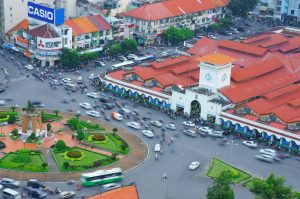Vietnam is projected to become the fastest growing economy in Asia this year, amid a regional downturn led overwhelmingly by China’s sharp economic deceleration, according to the World Bank.
In its most recent economic outlook report for East Asia and the Pacific, published yesterday, the World Bank forecast these regions to grow by 3.2 percent in 2022, down from 7.2 percent in 2021, before accelerating to 4.6 percent in 2023.
The projected growth rate for this year marked a significant reduction on the 5 percent that the World Bank forecast for the year in its last outlook report in April.
Much of this can be chalked up to the economic slowdown in China, which previously led the region’s recovery from the COVID-19 pandemic, before the country’s almost self-defeating strict “zero COVID” policy has slowed its economy. In its outlook, the World Bank projected China’s economy to grow by 2.8 percent this year and 4.5 percent in 2023, a “sharp deceleration” from the 8.1 percent that it recorded in 2021. In its last outlook, published in April, the Bank had predicted China would grow by 5 percent in 2022.
When China is taken out of calculations, forecast growth for East Asia and the Pacific actually increased to 5.3 percent, up from 4.8 percent in its April outlook. This represents more than a doubling of the region’s growth rate of 2.6 percent for 2021, and a sign that while the COVID-19 pandemic has not yet come to an end, its economic impacts have been largely ameliorated.
Perhaps the biggest story was the emergence of Vietnam as the fastest growing economy in East or Southeast Asia. Given the country’s combination of relatively effective COVID-19 containment measures, demographic advantages, and a privileged perch in the structure of the regional and global economy, the World Bank estimated that Vietnam’s economy will grow by 7.2 percent in 2022, up from its projection of 5.3 percent in April 7.2. It then projects it to grow by a further 6.7 percent in 2023. Of Southeast Asian nations, only the Philippines (6.5 percent), Malaysia (6.4 percent), and Indonesia (5.1 percent) were forecast to exceed 5 percent this year.
Elsewhere in the region, the picture was cautiously positive. The World Bank raised its economic forecast for Malaysia from 5.5 to 6.4 percent, and made similar upward revisions for the Philippines (5.7 to 6.5 percent), Thailand (2.9 to 3.1 percent), and Cambodia (4.5 to 4.8 percent).
In a press release issued in advance of the full report, the World Bank put this relatively strong growth down to three factors: the recovery of private consumption in the first half of 2022, “enabled by a relaxation of COVID-related restrictions”; the sustained global demand for exports of manufactured goods and commodities from East Asia and the Pacific; and the limited tightening so far of fiscal and monetary policy, though it noted that “pressures to tighten may increase” in the months ahead.
But the Bank also noted a number of headwinds facing the region, which has jumped from the frying pan of COVID-19 into the fire of economic slowdown due to rising inflation and the ongoing war in Ukraine. “The global economic slowdown is beginning to dampen demand for the region’s exports of commodities and manufactured goods,” the report stated.
It also noted the impact of inflation, and the interest rate increases initiated by central banks in the developed world particularly the U.S. Federal Reserve, in order to tame it. This tightened monetary policy has in turn “caused capital outflows and currency depreciations in some East Asia and Pacific countries. These developments have increased the burden of servicing debt and shrunk fiscal space, hurting countries that entered the pandemic with a high debt burden.”
The Southeast Asian exemplar of this is Laos, which is currently in the midst of a serious debt crisis after years of heavy borrowing from China, and saw its projected growth for 2022 slashed from 3.8 percent to 2.5 percent.
Another outlier is conflict-torn Myanmar, which the World Bank projected would “enjoy” a 3 percent recovery in 2022, up from the 1 percent that it estimated in April. But coming after a contraction of a scarcely believable 18 percent in 2021, this is far from an indication of positive economic development. Indeed, such is the uncertainty of Myanmar’s political and economic situation that the Bank declined to provide a projection for its economy in 2023.

































